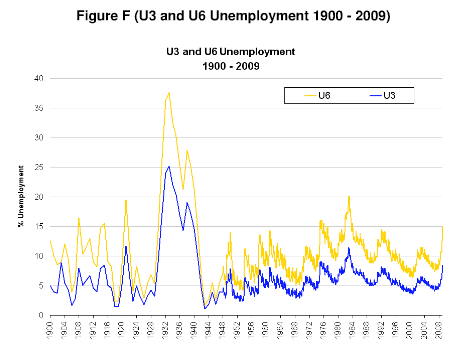The real Unemployment measruement the "U3 and U6" Measruement system
A frequent meme propounded in the economic blogosphere is that U6 unemployment, running near 17% now, is a truer measure (and there are
good reasons to believe it is), so that means we have unemployment
already approaching Great Depression levels of 25%. Left out of the
comparison is the fact that U3 and U6 measurements didn't exist during
the 1930s. So, is the 25% unemployment peak for the Great Depression a
fair comparison to U6 unemployment today?
N. Andrews compared historical versions of unemployment statistics with the modern U3 and U6 versions, published as "Historical Unemployment in Relationship to Today" , has an answer. He writes:
For the period of 1900 - 1947 we have two unemployment statistics available, Unemployed Non-Farm employees and Unemployed Civilian
Workforce. These two data sets pose a challenge as they were developed
during a period of ever-changing data collection methodologies. The
data in the sets has been adjusted by the sources listed in
Bicentennial Edition: Historical Statistics of the United States,
Colonial Times to 1970 in an attempt to sync the data sets with the
methodology that was put in place as of 1940 and was the basis for
methodologies since. We can compare the two available data sets ... and
we see that the Unemployed Non-Farm employees and Unemployed Civilian
Workforce measures of unemployment appear to be a close analogue of
modern U3 (Unemployed Civilian Workforce) and U6 (Non-Farm employees).
Based on that research, he was able to generate a mathematical formula to calculate U3 and U6 unemployment for the entire period since 1900. He found that at the peak of the Great Depression, U3 was 25.2%. U6 was 37.6%.
Here's the resulting graph:

to be false, and indeed, far off the mark. Using Nelson's methodology,
our currrent U3 and U6 unemployment are both very close to the figures
in 1930, which is bad enough. But they are less than half of the
unemployment that existed at the peak of the Great Depression.
Tags:
Replies to This Discussion
"Destroying the New World Order"
THANK YOU FOR SUPPORTING THE SITE!
Latest Activity
- Top News
- ·
- Everything
THE GREAT FLOOD Official Trailer (2026) Netflix | Global Disaster Movies 4K
Mothman Prophecies
The 100 Series Designated for SAC and a Possible WWIII
Human Be-In - Full Program - 1/14/1967 - Polo Fields, Golden Gate Park (Official)
Sebastion Piñera and 5G
© 2025 Created by truth.
Powered by
![]()